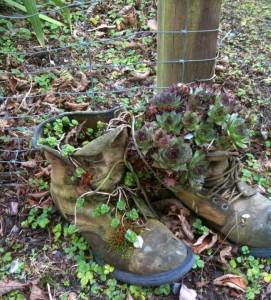
1. Circularity is a big help. It provides a sense that the reader has returned to the beginning, but now everything is changed. Here’s a cheat – take something that appears in your first three paragraphs and invoke it in your last three as well. It can be changed – the rose that initially trembled, dew-covered, as our heroine picked it is now lying withered and flat in the road. Or it is a new rose, being picked by another woman who is the replacement for the first?
For an example of this, I’m actually going to be obnoxious and point to my own story, Magnificent Pigs. Technically I cheat, because the object I used doesn’t appear until the fourth paragraph, the brass bed which creaks in protest as Aaron sits down. At the end it’s become the object of Jilly’s salvation, the vehicle that carries her away into the sky. There’s other reappearing things: pigs are mentioned right off the bat (in the title, even) and they’re crucial to the end. And the story begins and ends with the idea of death and (hopefully) changes your perception of it.
Here’s another example, taken from Joe Hill’s wonderful “Pop Art” in 20th Century Ghosts (Kindle edition) It begins with a paragraph that sets up the rules of the story gracefully and efficiently:
My best friend when I was twelve was inflatable. His name was Arthur Roth, which also made him an inflatable Hebrew, although in our now-and-then talks about the afterlife, I don’t remember that he took an especially Jewish perspective. Talk was mostly what we did — in his condition rough-house was out of the question — and the subject of death, and what might follow it, came up more than once. I think Arthur knew he would be lucky to survive high school. When I met him, he had already almost been killed a dozen times, once for every year he had been alive. The afterlife was always on his mind; also the possible lack of one.
We know that the story is about the narrator and his best friend, but the focus will be the friend. We know it will have funny moments, and many of those come from Arthur’s mouth, so we like him even more. We know that in this story, the surreal is fair game. We know that there can be fairy-tale resonances. And we know, immediately, that the story will be about Arthur’s death.
That death returns at the end of the story, which I will not include, because you should read the story without that particular spoiler. But I feel comfortable in revealing that Arthur’s death reappears at the end in the shape of two people talking about it. It’s a lovely, well-constructed story with a lot of clever structure to it.
2. Give the reader space in which to appreciate your ending, a sentence or two of standing back and letting the story tumble into meaning in their head. That’s what “Pop Art” does – doesn’t end with the actual death, but ends with a discussion of it, which provides a chance to extract additional meaning from the story.
Here’s the end to Carol Emshwiller’s equally lovely “Grandma,” from the collection, Report to the Men’s Club (Kindle edition). The story, told by an superhero’s grandchild, begins with a litany of actions that the grandmother has performed in her role as superhero, and ends with the decision to take up that role (although somewhat modified), given physical form:
I’m wearing Grandma’s costume most of the time now. I sleep in it. It makes me feel safe. I’m doing my own little rescues as usual. (The vegetable garden is full of happy weeds. I keep the bird feeder going. I leave scraps out for the skunk.) Those count — almost as much as Grandma’s rescues did. Anyway, I know the weeds think so.
3. Let the reader hear the door of the story click shut. John Barth said this in a workshop one time and it’s always stuck with me. This is related to number 2, but even more, it’s the idea of providing a line that says “The End” or the equivalent, and lets the reader know the story is over. Have you ever heard someone read and not been sure when to clap? Those readers need to close the door a little harder.
Here, for example, is the end of Pat Cadigan’s “Vengeance is Yours” from her collection Patterns.
That’s the funny thing about vengeance. Half the time people hire me, they’re getting back at the wrong persons for all the wrong reasons. I should know. I’m an authority.
But then again, the vengeance isn’t mine.
BOOM the door is shut and the story is over.
Like beginnings, endings are important, and worth spending some extra time on. They’re the last handshake on your reader/guest’s way out the door, the smile or clever goodbye that makes them sigh in satisfaction, sitting in their homeward bound taxicab: “Oh, that was such a good party!” A good ending lets the reader close the book then sit back and savor its perfection, reconciling them to the fact that the dream you spun is over.
Writing exercise: Grab a story whose ending doesn’t satisfy. Using your first three paragraphs, write an ending that returns to that scene and lets us know exactly what has and hasn’t changed.
Resources:
Online class: Moving From Idea to Draft
Nancy Kress’s tremendous Beginnings, Middles, and Endings.










21 Responses
There is NOTHING worse than a great story with a crummy ending. I confuses me; there are so many books that I loved how the characters were brought together and how well the plot was carried out and so have many other great things but… the ending…
Yeah, I think about two-thirds of the first novels I read end up falling up and not being satisfying. For a sample of one that does it well, I thought Jane Smiley’s A Thousand Acres did an AWESOME job of creating an ending that was sad but at the same time felt inevitable and a product of the actions in the book.
This post solved a short story problem I’ve been wrestling with since November. It took less than 15 minutes to fix the ending, based on your guidance. If you’d like to see the before and after, let me know.
Karen (“The Other Karen Anderson”)
I’d love to see it!
Well put! I enjoyed your advice immensely. My writing will benefit from this, thank you!
The finest examples of circularity that came to mind reading this post was Tolkien’s evocation of Tom Bombadil, after Frodo has boarded the ship heading out to the West:
“And then it seemed to him that as in his dream in the house of Bombadil, the grey rain-curtain turned all to silver glass and was rolled back, and he beheld white shores and beyond them a fair green country under a swift sunrise.”
And it really shouldn’t work, at least not as well as it does. The hobbits’ adventure with Old Tom was a brief interlude that occurred well after the beginning of the story, and he was never mentioned again until here on what is practically the final page. Yet somehow it does; indeed, it works so well that Annie Lennox used that singular image in her song “Into the West”.
Rules are made to, if not actually be broken, have noses thumbed at them.
That’s an awesome example. I wonder if it works so well because Bombadil is so different from the other characters, standing aside from the struggle the rest are involved so deeply in?
Going to go find the Lennox song right now.
I want to thank you immensely for making this! I had no idea what my teacher meant when he told me “your story just stops it doesn’t end” (confused me a bit seeing that, well, it ended didn’t it?)
So yeah thanks you (you are also a genius)
I am very glad it was useful, Emily!
i loved this
Zandra, I totally agree with you. This thing is ROCKIN’ awesome!
Hey, Cat, have you ever wished that there was a law stating that a book can not be saying ” To be continued… “? ” To be continued… ” make me feel so.. Umm… You know… Wanting to get another book from the series! Argh!
Well, I ended Beasts with a HUGE cliffhanger, so I’m guilty of that myself. 🙂